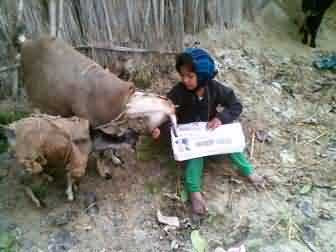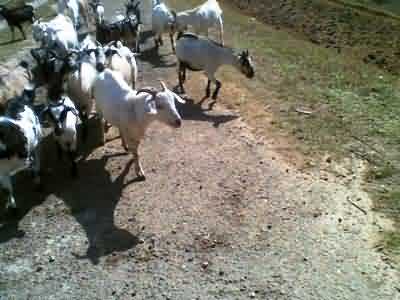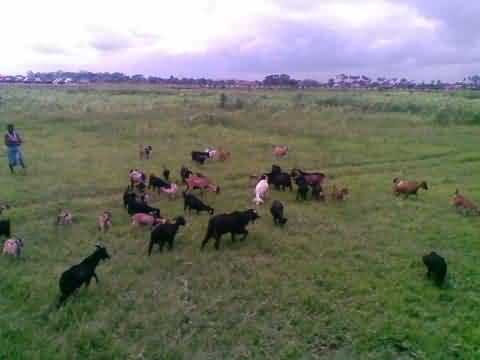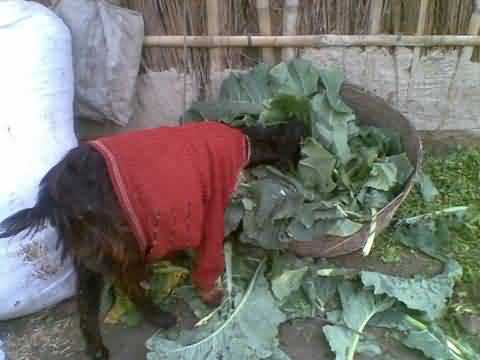बकरी पालन - ग्रामीण किसानों के लिए आय का सबसे अच्छा स्रोत

Goat production for milk and meat is an age old practice and goat is one of the first animals to be domesticated by men. Throughout the world goat is considered as ‘poor man’s cow’. Central Institute for Research on Goats (CIRG) projected as ‘Future Animal’ for rural and urban prosperity.
The total goat population in India is 125.7 million, which is 14.6% of total world’s population. India produces 4.0 million MT goat milk by 30.2 million dairy goats.
India is the largest goat milk producer in the world, followed by Bangladesh (2.2 million MT) and Sudan (1.5 million MT).
China produces about 1.8 million MT meat (highest in world), followed by India (0.5 million MT) and third is Nigeria (0.3 million MT).
In India, goat sector contribute about 14,453 crores, out of which 6851 crore from meat, 4588 crores from milk and 648 crores from skin, which is 8% of total GDP from livestock sector and generate 4% employment directly or indirectly in the country. Approximately 20 million small and marginal farmers depend on goat rearing.
Why to go for goat farming?
- There is no religious taboo attached with goat farming or with goat meat (chevon) and all sections of the society readily consume goat meat.
- Chevon contains low cholesterol and a lean meat than red meat.
- Comparatively low investment is required for starting a goat farm.
- According to availability of land, labour and capital the goatery can be started with one unit of goat to a large commercial farm which suits a small marginal farmer or a big industrialist.
- In small scale goatery family labour can be efficiently utilized who cannot go for other farming activity (e.g. Children or old member of the family).
- Due to fastidious eating habit goat can thrive in all agro-climatic condition of the country.
- Goat can consume all kinds of plant which are generally rejected by the other animals and also can withstand more bitter taste.
- They are naturally browsing in nature and can easily pluck feed from trees, bushes and shrubs.
- Due to small fat globule present in goat milk, it is easily digested and medically recommended for infants and aged people.
- Goats are prolific breeder and mature at the age of 10 to 12 months. In small breeds like Black Bengal or Assam Hill it is only 6 to 7 months. By 16 to 17 months goats starts milking.
- Three kidding in two years and twin birth is very common in goat, thus ensure more economic return in a short period.
- Goat can thrive in almost all region of the country and generate employment for rural masses.
- Goat manure is rich in nitrogen, phosphorus and potassium and is excellent manure for agricultural production.
Region wise distribution of goat breeds in India
- Northern Temperate Region- Comprises Jammu & Kashmir, Hilly regions of Uttarakhand and Utter Pradesh. Breeds available in this region are Chegu, Changthangi, Gaddi and Kashmiri Pashmina.
- North- West arid and Semi-arid region- Rajasthan, Haryana, Punjab, Plains of Uttar Pradesh, Madhya Pradesh and Chattishgarh. Breeds are Sirohi, Jhakrana, Beetal, Barbari, Jamunapari, Surti, Zalawadi, Marwari and Kutchi.
- Southern peninsular region- State includes Andhra Pradesh, Tamilnadu, Karnataka, Kerala, Maharashtra and other central parts of India. Goat breeds of this region are Osmanabadi, Sangamneri, Kannaiadu and Tellichery or Malabari.
- Eastern and North- Eastern Region- Bihar, Orissa, West Bengal, Sikkim and Seven Sisters i.e. Arunachal Pradesh, Assam, Nagaland, Manipur, Meghalaya, Mizoram and Tripura. Bengal or Black Bengal, Assam Hill and Ganjam are the prominent breeds of this region.
Goat production systems in India
- Extensive production system
- Stall-fed and intensive production system
- Semi-intensive production system
- Integration with cropping or fishery system
Selection of Goat breeds for Milk, Meat and Fur production
- For milk production Jamunapari, Surti, Beetal, Barbari. Suitable breeds for meat production are Black Bengal, Assam Hill, Ganjam, Sirohi, Jhakrana, Osmanabadi, Sangamneri etc.
- For fur and mohair production Chegu, Changthangi, Gaddi, Kashmiri Pashmina breed may be considered. All most all breeds of goat may be considered for milk and meat production and by products are hide and manure.
Management practices for goat production
Housing management
The goat house should always be protected from hot and cold wind, humidity, solar radiation and rain. The house should have east-west orientation. Shed should be constructed on elevated land and free from water logging or marshy areas. For small unit goat farming no elaborate housing is necessary. Locally available material like bamboo, wood, elephant grasses, paddy straw etc may be utilized to reduce the cost for construction.
The goat house should be well ventilated well-drained and easily cleaned. The bucks should be individually housed with floor space of 2.4 x 1.8 sq mt. Group housing for does may be provided with at least 1.8 sq mt/ doe and in group housing 60 does may be placed in a single pen. For 10 kids 1.8 x 1.8 sq mt is sufficient. Crowding or overstocking may be avoided.
Elevated wooden or concrete floor with 1.2 mt height sidewall and wire/ bamboo netting may be provided for well ventilation and direct sun light. The sick animal should be housed separately with at least 3 x 2 sq mt floor space.
Feeding management
Goats are having fastidious eating and browsing habit. They can thrive on a variety of feed including agricultural by-products or wastes which are generally avoided by other livestock. Goat can withstand more bitter taste than the other animals. That is why they can thrive in all weather conditions prevailing in the country.
Due to prehensile tongue and mobile upper lip goat can graze on very short grasses and also can browse in trees, bushes or shrubs. For yielding more milk and high quality meat, the goat should be provided concentrate mixture and leguminous fodder in their diet. On an average a goat can consume 5 to 7 kg of green fodder per day.
Fodder like maize, jower, oat Lucerne, berseem, cowpea, pea and grasses like hybrid napier, paragrass, dub etc and tree leaves viz. jackfruit, mango, subabool, banyan, mulberry, neem etc. Agricultural by-products as cabbage, cauliflower, carrot, radish etc also can be fed to the goats without any adverse effect.
At least ⅔ of the energy should come from roughages and half of the roughages should be leguminous fodder. Concentrate mixture should have minimum 14 to 16% crude protein with sufficient energy, minerals like calcium, phosphorus etc and vitamins.
- Immediately after birth kid should get colostrums and thereafter up to 5 days to develop better immunity.
- Up to 2 months kids may be provided does milk @ 1/10th of their body weight.
- For growers concentrate mixture should be given @100 gm/ day.
- For an adult doe or buck the ration should be 200 to 250 gm/ day.
- Before giving birth a pregnant doe must get concentrate mixture 250 to 300 gm/ day and before 7 to 10 days of parturition concentrate mixture may be gradually reduced and fodder increased for easy delivery.
- An adult goat can consume 1 liter of water per day. There should be provision for al libitum clean drinking water throughout the day.
Breeding management
Successful breeding of goat depends on right selection of doe and buck. Generally female goats become mature at the age of 6 to 10 months depending on the breed, size and weight. Male goats become mature at 12 months of age. Two kidding in three years is ideal for a goat farm.
At the interval of 8 to 9 months doe may be bred for optimum production. In goat there is two peaks breeding season i.e. from March to May and September to November. Oestrus cycle is repeated every 17 to 21 days and doe remains in heat for 18 to 36 hours. The doe should be met with buck after 10 to 15 hours of onset of heat for better conception rate.
Gestation period in goat is 145 to 155 days. The male can be utilized for breeding purposes up to 8 to 10 years and female 5 to 7 years. A teaser buck may be used for heat detection in does.
Selection of breeding stock
Ready to breed and at the prime stage of production may be considered for ideal breeding stock. Pedigree of the animal may be ascertained during purchase of new stock. With good health and vigour may only be considered during selection of breeding stock. The newly purchased animal may be vaccinated against diseases particularly for infectious diseases.
The stock may be kept under observation in an isolated place at least for 15 days. During pick summer and winter kidding may be avoided to prevent mortality. After 6 years of age animal may be culled from breeding stock and newly purchase or own farm stock may be used as replacement. Always an optimum level of male, female ratio should be maintained in the farm.
In breeding should be avoided. After every 2 to 3 years male may be replaced with new one for best production performance. A breeding register may be maintained in the farm for day to day record.
Care for newborn kids
Immediately after birth the mucus may be cleaned with a cloth from nose, mouth etc for easy respiration. Kids may be allowed to lick by doe for future identification by mother and to develop mother- offspring instinct.
Naval cord should be severed at 2.5 cm away from kids’ body and antiseptic like Tincture of Iodine may be applied to prevent naval ill. After successful delivery the udder of the doe may be cleaned with antiseptic lotion and immediately after birth kids should be provided colostrum and may be continued for 4 to 5 days. Overfeeding must be avoided to prevent kid scour.
If kids are born more than 2, extra goats/cows/ powder milk may be provided by a nipple fitted with bottle at least for 1½ to 2 months. In winter gunny bag, straw, wheat bhusa or sow dust may be provided as bedding materials for kids. In summer months energy drinks like cold glucose water may be provided to prevent sun stroke.
Castration of male kid
Male kid may be castrated at the age of 1 to 2 months for better meat quality, higher market price and unwanted breeding in the flock.
Health care management
- The goat shed should be cleaned with disinfectants at least once in a month.
- Adequate floor space (1.2 to 4.0 sq mt/ goat) may be provided to avoid overcrowding.
- Feed and water troughs should be cleaned regularly.
- Deworming at least twice in a year should be done to prevent endoparasites.
- For tick, mite, lice etc dipping or spraying with ectoparasitic drugs is recommended at regular interval.
- Vaccination for PPR. FMD, Goat Pox etc should be done periodically.
- Care should be taken for prevention of infectious and zoonotic diseases in the farm.
- Isolation of sick animals is must to prevent further loss to the flock.
- Stray animals should not be allowed to room free in farm premises.
- Vaccination at advance stage of pregnancy may be avoided.
- Timely care should be taken for diseases like diarrhea, bloat, indigestion etc to avoid unnecessary loss.



Authors:
¹ Dr Asit Chakrabarti, ² Dr Rajni Kumari, ³ Dr Shanker Dayal and ⁴ Dr AmitavaDey
¹ Senior Scientist (LPM), ² Scientist (Anim. Biotech.), ³Senior Scientist (AGB) and ⁴ Principal Scientist (AN) & Head
Division of Livestock & Fishery Management
ICAR Research Complex for Eastern Region
ICAR Parisar, P.O. Bihar Veterinary College, Patna- 800014, Bihar
¹ E-mail:
